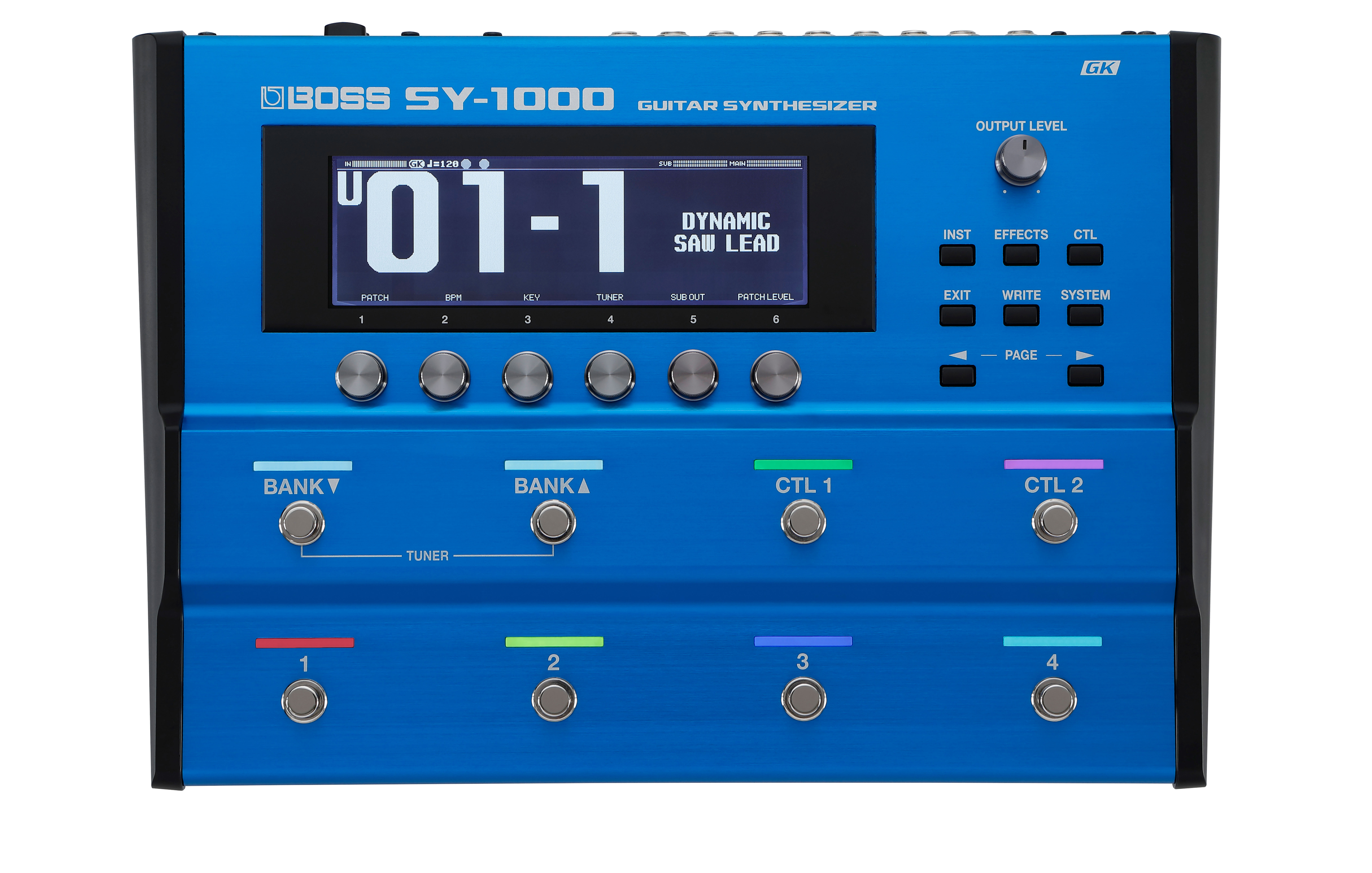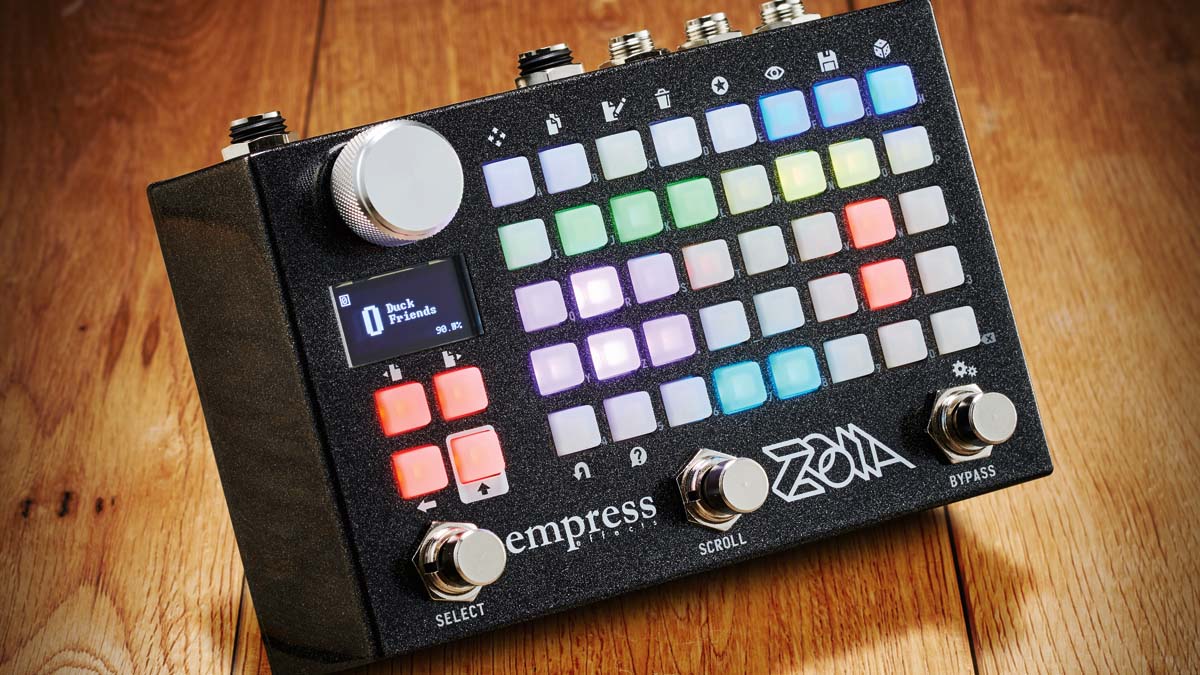MusicRadar Verdict
A paradigm-shift for effects pedals, the Zoia takes modular synth tones and functionality and joins them in blissful technological union with guitar multi-effects for a unit of exceptional musical potential.
Pros
- +
You can customise your own effects.
- +
Believe it or not, it's easy* enough to use!
- +
The sound is phenomenal.
- +
Functions as a standalone synth.
Cons
- -
No stereo headphone output.
- -
It'll take a bit of time to fathom its depths.
MusicRadar's got your back
What is it?
There are new effects and there are new effects. The Empress Effects Zoia is both. C'mon, just look at it. It's a multi-effects pedal, Jim, but not as we know it.
Yeah, and it's a modular synth, too, pal. But not as we know it. Indeed, this is nothing as we have ever known it so it is a real leap of faith in Empress Effects' R&D team has taken, not just in their design being excellent and worthy of a price just south of 500 bucks, but in us as guitarists. C'mon, we're primitive beings!
Sure, here we were having just gotten the hang of presets and – gosh, heck! – and then USB connectivity, MIDI functionality, impulse response and all that jazz, and now this. But if there's great tone in it, if there's something new to discover, then all right, pass us the manual.
The elevator pitch is this: forget the amount of buttons on the front. It's all very easy. The Zoia lets you custom-create your own effects, play around with the synth, and save all these settings down.
Yes, the grid of multi-coloured buttons looks intimidating but logic – and good design – will get you going in short order. Perhaps it is best to think of them as patches on which you can build a virtual pedalboard.
Press on a button, choose a module from the screen menu via the rotary dial and the buttons will light up, each representing the module's parameters. You then press the button and adjust the parameter via the rotary dial. You can link modules together by holding the buttons down simultaneously.
It is easier in practice than it is to describe, and in many respect the modular synth layout builds on the fundamentals of guitar pedal design. The difference with the Zoia is that you can customise your own effects.
There are 64 patches onto which you can save your work, and these are easily accessible via the Scroll and Select footswitches. Or hook it up to MIDI to really open the possibilities out before you. As Empress Effects call it, the Zoia is an "infinite-trick pony."

Performance and verdict
For the uninitiated in the business of hooking up synth modules, Empress has included a suite of ready-made effects for guitarists to get into and play around with.
The amount of modules available is growing all the time, at the suggestion of a growing online community of users and via regular firmware updates.

• Boss SY-1000
Launched last year, the SY-1000 builds on Boss's groundbreaking SY-300, incorporating some of the GT-1000 multi-effects processor's layout for a user-friendly trip into some incredible guitar tones.
• Line 6 Helix
Okay, so the synth approach to multi-effects is not your bag? The flagship Line 6 offers a traditional alternative with incredible user experience and heaps of incredible tones.
When we took receipt of the Zoia it had 20 effects modules including EQ, overdrive/distortion, fuzz, compressor, noise gate, phaser, flanger, chorus, vibrato, tremolo, envelope filter, ring modulator and cab simulator – and two delays and five reverbs partly that we've seen before on Empress’s Reverb pedal.
This is just a taste of what's possible, though. Once you get to grips with the logical editing process the sky is the limit. This is the sort of paradigm-shifting unit that makes you rethink how you see your pedalboard.
Take the most earth-bound effect: overdrive/distortion. Now, the module here might not make your beloved TS9 obsolete (indeed, there's an effects loop in for incorporating external effects) but it sounds incredible all the same.
And the overdrive/distortion module has all different flavours of gain. There's Plexi, Germ, Classic, Pushed, Edgy... When you dial in your gain, sculpt it with the Tone Control EQ module then, say, run it through a cab sim module, et voila!
That's just a basic example of how you can think about your signal path and make it a reality via the grid of buttons, patching those modules together. Deeper editing could create some really dynamic effects, like a flanger with a deeper sweep the harder you pick, or a vibrato that speeds up.
The Zoia is going to blow your mind one way or another. It helps to get familiar with some common synth terms – envelope, LFO, VCA and so on – before getting started with it, but our advice would be to try one out and see for yourself A) how much fun this is, and B) for an indication of how profoundly you can shape your tone.
New tech like this sometimes confounds us but good design soon has us facing the right way. Empress have thought this one out. With a little thinking from us, that mind we said would blow will be full-on galaxy brain in no time, and your guitar might never sound the same again.
MusicRadar verdict: A paradigm-shift for effects pedals, the Zoia takes modular synth tones and functionality and joins them in blissful technological union with guitar multi-effects for a unit of exceptional musical potential.
The web says
"As we’ve said many times over now, ZOIA is a hybrid sound machine. While it is clearly a jack of all trades, one would be foolish to call it a “master of none”. ZOIA can be what you want it to be for whatever type of music you make. And that, as far as we are concerned, is creative power and inspiration."
Attack Magazine
"The ZOIA is one of a kind. It’s not the most user friendly. But it is unique. And if you’ve ever dreamed of designing your own effects but don’t want to breadboard a new circuit every time you get an idea, then the ZOIA is unquestionably for you
Engadget
Hands-on demos
The Pedal Zone
Loopop
Guitar Bonedo
True Cuckoo
Red Means Recording
Empress Effects
Specifications
- ORIGIN: Canada
- TYPE: Multi-effects/synthesizer
- FEATURES: 20 ready-made effects; 23 audio modules; 22 control modules; 16 interface modules; 3 analysis modules; 64 writable patches; MIDI in/out; CV in/out; exp. pedal; ext. switch; 3x assignable footswitches
- CONTROLS: 1x rotary knob; buttons: 4x utility buttons (Page Left/Right, Back and Shift); 40x module grid/ page buttons (alternative/Shift functions include Move, Copy, Edit, Delete, Star, View, Save, Random, Undo, Help and Configure Menu); Select, Scroll & Bypass footswitches
- CONNECTIONS: Left/right input & left/right output standard jacks; Control Port jack for ext. switch/exp. pedal/MIDI in & out/0-5V control voltage in & out; 2x MIDI mini jacks: in & out (2x 3.5mm/5-pin dongles supplied); micro SD card slot (card and adaptor supplied)
- POWER: 2.1mm centre negative 9V DC adaptor (not supplied); 300mA current draw
- DIMENSIONS: 145 (w) x 95 (d) x 67mm (h)
- CONTACT: Empress Effects
MusicRadar is the number one website for music-makers of all kinds, be they guitarists, drummers, keyboard players, DJs or producers...
- GEAR: We help musicians find the best gear with top-ranking gear round-ups and high-quality, authoritative reviews by a wide team of highly experienced experts.
- TIPS: We also provide tuition, from bite-sized tips to advanced work-outs and guidance from recognised musicians and stars.
- STARS: We talk to musicians and stars about their creative processes, and the nuts and bolts of their gear and technique. We give fans an insight into the craft of music-making that no other music website can.
Baby Audio's Smooth Operator spectral balancing plugin goes pro
"It was ugly, like watching a divorce between four people. After a while, I had to get out": Beatles engineer Geoff Emerick on the recording of Abbey Road, track-by-track
"I said, “What’s that?” and they said, “It’s what Quincy Jones and Bruce Swedien use on all the Michael Jackson records": Steve Levine reminisces on 50 years in the industry and where it’s heading next











